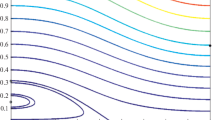Abstract
Differential equations are derived for studying the effects of either conservative or nonconservative torques on the attitude motion of a tumbling triaxial rigid satellite. These equations, which are analogous to the Lagrange planetary equations for osculating elements, are then used to study the attitude motions of a rapidly spinning, triaxial, rigid satellite about its center of mass, which, in turn, is constrained to move in an elliptic orbit about an attracting point mass. The only torques considered are the gravity-gradient torques associated with an inverse-square field. The effects of oblateness of the central body on the orbit are included, in that, the apsidal line of the orbit is permitted to rotate at a constant rate while the orbital plane is permitted to precess (either posigrade or retrograde) at a constant rate with constant inclination.
A method of averaging is used to obtain an intermediate set of averaged differential equations for the nonresonant, secular behavior of the osculating elements which describe the complete rotational motions of the body about its center of mass. The averaged differential equations are then integrated to obtain long-term secular solutions for the osculating elements. These solutions may be used to predict both the orientation of the body with respect to a nonrotating coordinate system and the motion of the rotational angular momentum about the center of mass. The complete development is valid to first order in (n/w 0)2, wheren is the satellite's orbital mean motion andw 0 its initial rotational angular speed.
Similar content being viewed by others
References
Beletskii, V. V.: 1965,Motion of An Artificial Satellite About Its Center of Mass. Translated from Russian by the Israel Program for Scientific Translations, Jerusalem.
Byrd, P. F. and Friedman, M. D.: 1954,Handbook of Elliptic Integrals for Engineers and Physicists, Springer-Verlag, Berlin.
Cochran, J. E.: 1971,AIAA J. 9, 6, 1195.
Cochran, J. E.: 1972,Celes. Mech. 6, 127–150.
Crenshaw, J. W.: 1968, Dissertation, Auburn University, Auburn, Alabama.
Crenshaw, J. W. and Fitzpatrick, P. M.: 1968,AIAA J. 6, 2140.
Fitzpatrick, P. M.: 1970,Principles of Celestial Mechanics, Academic Press, New York.
Hitzl, D. L. and Breakwell, J. V.: 1971,Celes. Mech. 3, 346–383.
Holland, R. L. and Sperling, H. J.: 1969,Astron. J. 74, 490.
Liu, J. J. F.: 1971, Dissertation, Auburn University, Auburn, Alabama.
Liu, J. J. F. and Fitzpatrick, P. M.: 1970,Semiannual Report (November 1, 1969–May 1, 1970), NASA Grant NGR-01-003-036, Dept. of Math., Auburn University, Auburn, Alabama.
Whittaker, E. T.: 1964,A Treatise on the Analytical Dynamics of Particles and Rigid Bodies, Cambridge University Press, London.
Author information
Authors and Affiliations
Rights and permissions
About this article
Cite this article
Liu, J.J.F., Fitzpatrick, P.M. Poisson equations of rotational motion for a rigid triaxial body with application to a tumbling artificial satellite. Celestial Mechanics 12, 463–487 (1975). https://doi.org/10.1007/BF01595391
Received:
Issue Date:
DOI: https://doi.org/10.1007/BF01595391



